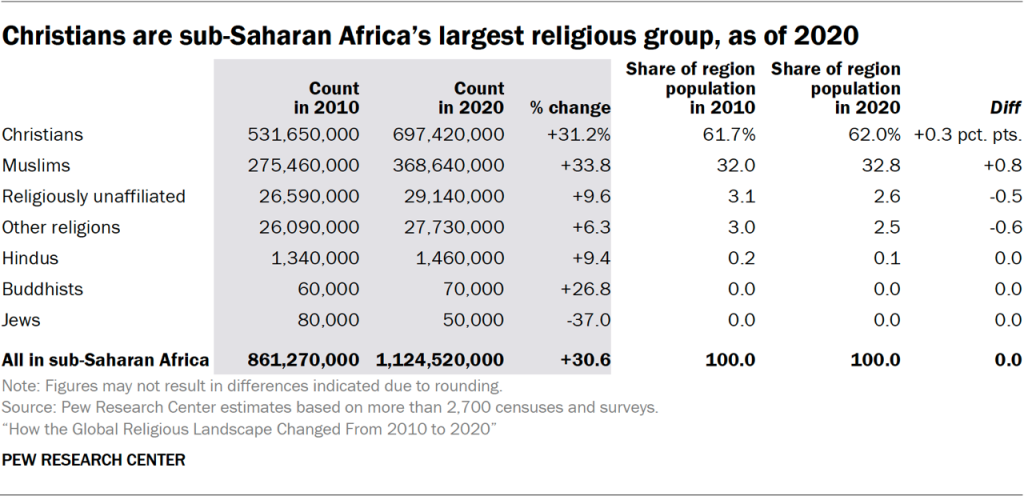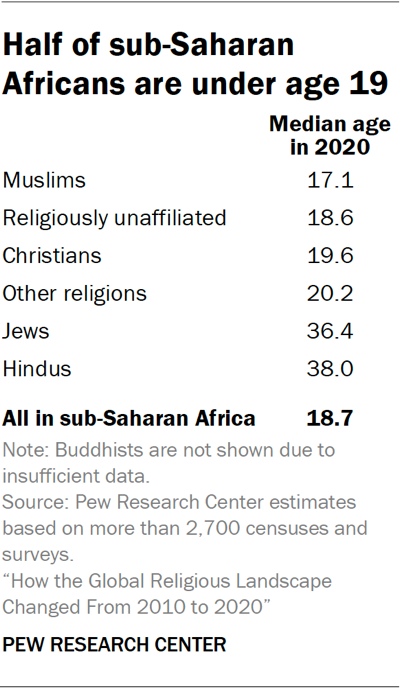Between 2010 and 2020, the population of sub-Saharan Africa grew by 31% to 1.1 billion. As of 2020, most people living in the region are Christians (62%), while Muslims make up about a third of the population. Religiously unaffiliated people and followers of other religions (which include African traditional religions) each account for roughly 3% of the overall population.
Sub-Saharan Africans are younger and have a higher fertility rate, on average, than people in any other region, leading to growth among all religious groups except for Jews. From 2010 to 2020, sub-Saharan Africa accounted for most of the increase in Christian numbers, globally.
Christians and Muslims, who together make up 95% of sub-Saharan Africans, are not evenly distributed in the region or even within many countries. Muslim-majority countries are in the north, closer to North Africa and the Middle East, while Christian-majority countries are in the south. This north-south divide appears in some countries, too. In Nigeria, for example, Muslims and Christians make up similar population shares but typically live in the north and south, respectively. A similar dynamic in Sudan contributed to the division of Sudan and South Sudan in 2011.
Measuring traditional religion and religiously unaffiliated populations in the region can be difficult. For example, older, traditional beliefs – including animism and Indigenous religious traditions – are often integrated into the monotheistic religions, making it hard to separate Christians and Muslims from people who fall in the “other religions” category.

Religious change
Sub-Saharan Africa’s overall population is growing fast, and the same is true for its two largest religious groups.
Between 2010 and 2020, the number (or count) of Christians grew to 697 million (up 31%), while Muslims increased to 369 million (up 34%). More than 29 million people in the region are religiously unaffiliated (up 10%), and 28 million identify with an “other religion” (up 6%), most commonly animism and other Indigenous traditions. Hindus number more than 1 million (up 9%), as of 2020. But across this region of over 1 billion people, Buddhists and Jews each number in the tens of thousands, as they did in 2010.
There were only small changes in the percentages (or shares) of the regional population these groups made up in 2020 compared with 2010. The share of the population that is Muslim changed the most, growing by roughly 1 percentage point to 33%. Christians increased their share by less than half of a percentage point, to 62%. The religiously unaffiliated and “other religions” populations both declined slightly, but each still made up roughly 3% of sub-Saharan Africa’s population in 2020, as they did in 2010.
Substantial change within countries
Across sub-Saharan Africa, the largest substantial change (of at least 5 percentage points) in a religious group’s share of a country’s population occurred in Guinea-Bissau, where the religiously unaffiliated grew to represent 12% in 2020, up 9 percentage points from 2010. In the same country, the share of people belonging to other religions fell to 11% (down 7 points).
Mozambique is the only country in the region (and in the world) in which Christians substantially increased their share of the population, growing to 61% (up 5 points). A government-led anti-religious campaign in Mozambique officially ended in the 1980s, and the share of its population that is Christian has been increasing since then.
Other changes also occurred:
- Christians declined in Benin, Namibia and Cape Verde.
- The percentage of the population identifying as Muslim increased substantially in one country (Benin) and fell in one other (Tanzania).
- The share of religiously unaffiliated people expanded in three countries (Guinea-Bissau, Cape Verde and Namibia).

Median age of religious groups

Sub-Saharan Africa has the youngest population of any major region of the world. With a median age of 19, young people make up most of the region’s population. Christians tend to be older than Muslims across the region, with median ages of 20 and 17, respectively. People in the “other religions” category also have a median age of about 20. (There is not enough information available about the age structure of Buddhists in the region to make a reliable estimate of their median age.)




